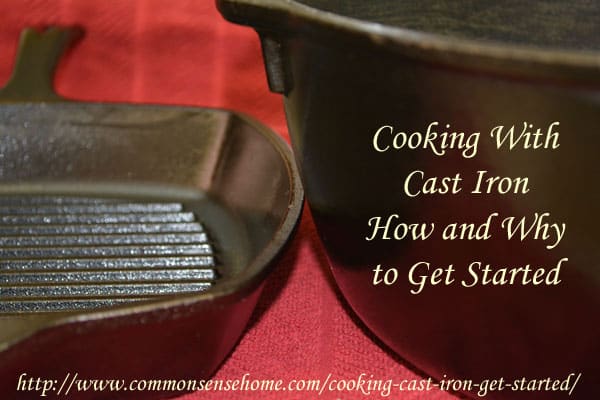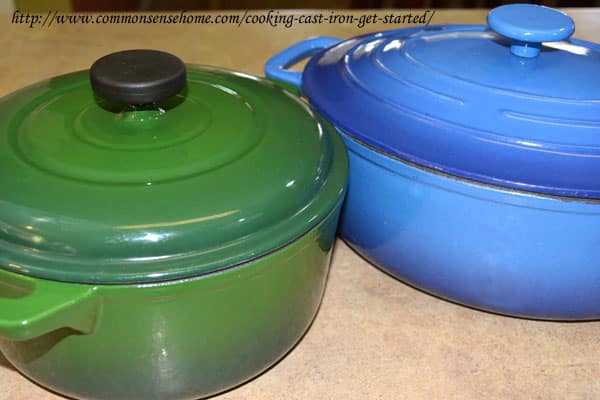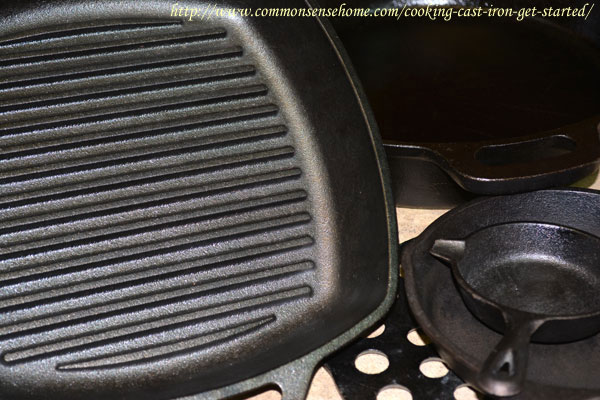Cooking With Cast Iron—How And Why To Get Started
Cooking with cast iron was one of the first back to basics moves I made; I wish I could say it was intentional, but the truth is I fell into it out of circumstance. When my sons were younger my husband and I led their Cub Scout pack, and over the years of endless campouts I learned to cook in Dutch ovens over campfires because I wanted my boys to have healthier food than traditional pre-packaged “camp food”. I’m a seasoned (pun intended…) cast iron user and I’ve been battling it, loving it, and learning from this traditional cookware for years. Yes, I say “battling” it because I didn’t know how to take care of it in the beginning. It’s not hard to take care of or hard to use; it’s just a little different. Luckily, the years of battling are over and now I’m just loving it. Let me share with you what I’ve learned.
Choosing Your Cast Iron Cookware Pieces
You can purchase almost any size cast iron cookware fairly easily. In recent years it has become popular again. It’s one of those “what’s old is new again” crazes because people are realizing other cookware is often not safe to cook with. You should purchase cookware based on what you cook most and the size of your family.Skillets: Most people start off with a 10in skillet. I recommend 12in if you have hungry boys like I do. Your skillet can be used for stir-frying, pan-frying, broiling, baking, roasting and simmering. I use my 12in skillet to cook everything from spaghetti sauce to cornbread.
Dutch Ovens: Dutch Ovens are also called camp ovens. They can be used for larger recipes as a simple pot or they can be used as a slow cooker. When used as a slow cooker they are especially good for cooking large cuts of meat which would otherwise be difficult to cook in an off-grid situation. They can also be used, as the name implies, as small ovens so you can bake cakes and other treats in them. In order to bake you must have a lid that will allow you to easily place coals on top, since the Dutch Oven must be heated evenly on the top and bottom for baking.
Griddles and Grill Pans: You can use a cast iron grill to roast vegetables or a griddle to fry pancakes. The griddle heats evenly so you don’t have a pancake that is done in one area but not in another.
Reasons To Use Cast Iron Over Other Cookware
- Off-Grid Cooking- One of the biggest assets to cooking with cast iron is that it can be the only cookware you own. You can cook in any environment with one set of cookware. This saves money and storage room. It also insures that you will have cookware no matter where you are cooking or in what situation you find yourself.
- Naturally Non-Stick- Cast iron is naturally non-stick because of the patina that forms when you season the cookware. If you treat your cast iron like you would any other non-stick cookware and use appropriate utensils (I use wood) the coating will stay on and prevent food from sticking
- Lasts Forever- You can’t wear out a cast iron skillet. The truth is that the older they get the better they perform because over time the surface gets smoother. So you save money by not having to replace your cookware every few years.
- Heats Evenly- As I mentioned above cast iron heats evenly which prevents food from burning and drying out.
- Non-Toxic- Cast iron cookware is made of, you guessed it, iron… It’s not made of Teflon or some other toxic or questionable material. You can feel comfortable cooking for your family with cookware that has been proven safe through the ages. Actually, if you do cook with cast iron there may be a health benefit – some of the iron leaches into the food to give you a boost in your iron intake.
- Can Be Used With High Heat- Cast iron can go from the stove to the oven to the campfire with no problem. This can save time and effort as you can start a meal in a skillet on the stove and finish it in the same skillet in the oven.
- Easy Care and Clean-up- Yes, I know some of you are skeptical, but once you get the hang of it cast iron is as easy to care for as any other non-stick cookware.
Care Of Traditional Cast Iron Cookware
Food will stick to cast iron if it’s not seasoned. Seasoning is the process of coating cookware with oil and then heating it so a patina (or thin layer) is formed from the cooked oil. Most cast iron sold today comes pre-seasoned, and the older pieces you might find at a thrift store or yard sale will most likely be seasoned. You have to continually add oil or fat to keep your cookware seasoned. If you cook with a lot of oil or fat you might not have to do what I call “maintenance” seasoning. However, most of us try to watch our fat intake, even from healthy fats, and you actually cook with less oil in a well-seasoned cast iron pan. So here’s a simple care procedure:- Use a non-stick surface scraper to remove unwanted food from the pan.
- Rinse your pan out with water. There is a bit of controversy about using soap to clean your cast iron cookware. Many people swear by not using soap. I generally do not use soap but there is a risk of bacteria staying in the pan. So if someone in my family is sick I might use a bit of soap. The heat will eventually kill the bacteria but it might not kill it right away since the oil application is done at a low temperature. Never place a hot pan or pot in cold water because this could cause cast iron to crack.
- Dry completely. This is important because cast iron will rust if moisture is left on the surface too long. If your pan does rust use steel wool in the affected area. Then proceed to the next step.
- Heat your pan on low to medium heat.
- Apply a thin layer of oil with a lint-free cloth. You can use bacon grease, lard, coconut oil or any other high heat oil (I use coconut oil). Applying too much will cause the pan to be sticky. Let it cool and wipe off the excess oil.
You should store your cast iron without a lid to keep rust from forming, especially if you live in a humid environment. I do stack my cookware and sometimes I do store them with the lids loosely on, but I place a brown paper bag in the bottom of the pan or pot to absorb moisture and excess oil.
Cooking with Cast Iron
- Pre-heat your pan if frying. Too much heat too fast can also crack a cast iron pan.
- Treat your pan like any other non-stick cookware and do not use metal utensils.
- Cook over low heat. Since cast iron heats evenly you don’t need as much heat.
- Remove acidic foods as fast as possible. Don’t leave spaghetti sauce sitting in you pot. (Acidic foods will have a darker color when cooked in cast iron because of the iron absorption.)
- Do not store food in cast iron cookware. Cast iron will rust from the moisture in the food.
- Do not boil water routinely in your cast iron pots because it will take off the seasoning.
- Cast iron is heavy. This is a good thing for most of us who could use a little weight lifting in our lives, but extra caution should be taken with children and adults with limited mobility.
- Caution should be taken if you suffer from Hemochromatosis or iron overload.
- Also, there is some debate about the type of iron absorbed through cooking with cast iron, as to whether it can absorbed by the body because it’s not organic iron. You can read more about this at http://learningandyearning.com/cast-iron



No comments:
Post a Comment
Note: Only a member of this blog may post a comment.